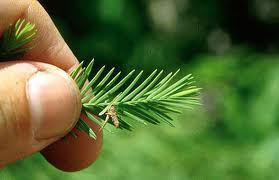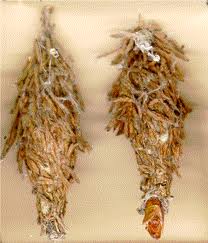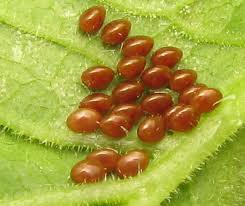NMSU Plant Diagnostics
NMSU Plant Diagnostic Clinic is housed on the main campus in Las Cruces. The clinic is a full testing laboratory helping professionals and homeowners alike learn more about their plants, gardens, landscape, parks, and agriculture production fields. Click the following links to learn more:
Ants
Ants do have wings and may swarm in your house. The following links have tips to control Ants in the Home and Home landscape
Aphids

Bagworms


Live young mobile bagworms were brought into the Bernalillo County office the week of June 20th.
What can I do about bagworms? Because it is early in their development, they are easier to control now than they will be later. Spray the foliage of the tree with either a Bt or Spinosad product. Both are effective against caterpillars, which is what the bagworms are. The Bt product, a naturally occurring bacterial disease of insects, is very targeted to just caterpillars, but will only last a few days after application. Spinosad has a wider range of insects it can damage, including bees; as long as the tree is not in bloom that should not be a problem. Spinosad will have an effective period of about a week after application. In either case, we suggest treating the tree about three times, one week apart, to really target the bagworms now while they are small and more vulnerable.
Read a NMSU Fact Sheet on bagworms
Watch the SW Yard and Garden - Bagworms on identifying bagworms video and other insect pests on your trees.
Crickets
Chirp Chirp Chirp...
Squash Bugs


Squash bugs are back. Let's play "Squash the squash bugs" !! Be on the look out and start scouting and "squashing"
Squash bugs are sucking insects that inject a bacterial toxin into the plant causing pumpkins, zucchini, and other squashes to wilt and die.
Controlling adult squash bugs is difficult, and chemical controls do very little. The best control method is physically removing the squash bugs and destroying the eggs. Placing a row cover over your plants and anchoring the ends down may also help.
According to Dr. Sutherland (NMSU Entomologist), squash bugs are very difficult to control. Manual removal is the most effective manner for homeowners to manage this common garden pest. Most insecticides available to homeowners (organic or otherwise) have limited effectiveness when used to treat the insect in the adult stage. They are most effective within a few days after the eggs hatch. She suggests that you take a hint from their name and "squash" the squash bugs. Be sure to inspect the underside of the leaves for bugs and clusters of reddish-brown eggs. She suggests that you hand pick (or scrape) the bugs and their eggs from the plant into a bucket of soapy water. In some cases, a severely infested leaf may be completely removed and many of the pests killed in the process.
Natural squash bug enemies include parasitic wasps (2 spp) that infest eggs; Insecticidal soap is okay on small young bugs; and some Neem products may be somewhat effective.
Many home remedies and home recipes to control squash bugs exist. NMSU Extension, in compliance with NMDA Pesticide laws and product label use, does not endorse any home remedy.
To read further about squash bugs, their life cycle, causal damage and control:
Cottonwood Leaf Blotch Miner

I have received many phone calls regarding leaf drop on cottonwoods and round "blotches" on the leaves. This is the cottonwood leaf blotch miner. This is a small moth that has a leaf-mining larvae. It is only a cosmetic concern. We are having an outbreak this year. It is not worth spraying because the caterpillars are too protected inside the leaves.
Systemic insecticides will take too long to be effective and the damage is already done. This is not going to threaten the health of the cottonwood in the long run!
Dr. Sutherland (NMSU Entomologist) had the following comments regarding the critter...
It seems like every 5-10 years or so we have an outbreak somewhere of Phyllonorycter, an extremely tiny moth in an obscure family no one has ever heard of. The moths are likely 5mm long or less and mature caterpillars inside those mines are about the same length. The moths apparently overwinter below the leaf litter under potential host trees.
They emerge in spring, mate and lay eggs in the blades of expanding leaflets. The caterpillars hatch, feed on sap first, then on leaf cells, creating blotch mines. They can pupate inside those mines but heavily mined leaves will likely fall off the trees very early - anytime now. A second generation - probably not a third - is produced seasonally. While so much defoliation could hurt a tree if it's extensive and prolonged, these critter have quite a few natural enemies that catch up with them in a year or so. Spraying the trees may not produce the desired results since the caterpillars are leaf mining. By the time a systemic would reach them - if ever - the damage is done, the leaves have fallen and the outbreak is grinding to a halt.
Home and Garden How To
Southwest Yard and Garden How-To Videos
Simple videos covering a variety of projects. Hosted by NMSU Extension (external link).
